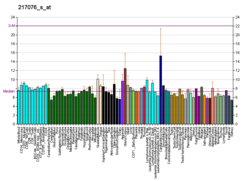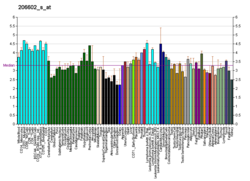HOXD3
Homeobox protein Hox-D3 is a protein that in humans is encoded by the HOXD3 gene.[5][6][7]
Function
This gene belongs to the homeobox family of genes. The homeobox genes encode a highly conserved family of transcription factors that play an important role in morphogenesis in all multicellular organisms. Mammals possess four similar homeobox gene clusters, HOXA, HOXB, HOXC and HOXD, located on different chromosomes, consisting of 9 to 11 genes arranged in tandem. This gene is one of several homeobox HOXD genes located at 2q31-2q37 chromosome regions. Deletions that removed the entire HOXD gene cluster or 5' end of this cluster have been associated with severe limb and genital abnormalities. The protein encoded by this gene may play a role in the regulation of cell adhesion processes.[7]
See also
References
- ^ a b c GRCh38: Ensembl release 89: ENSG00000128652 – Ensembl, May 2017
- ^ a b c GRCm38: Ensembl release 89: ENSMUSG00000079277 – Ensembl, May 2017
- ^ "Human PubMed Reference:". National Center for Biotechnology Information, U.S. National Library of Medicine.
- ^ "Mouse PubMed Reference:". National Center for Biotechnology Information, U.S. National Library of Medicine.
- ^ McAlpine PJ, Shows TB (Jul 1990). "Nomenclature for human homeobox genes". Genomics. 7 (3): 460. doi:10.1016/0888-7543(90)90186-X. PMID 1973146.
- ^ Scott MP (Nov 1992). "Vertebrate homeobox gene nomenclature". Cell. 71 (4): 551–3. doi:10.1016/0092-8674(92)90588-4. PMID 1358459. S2CID 13370372.
- ^ a b "Entrez Gene: HOXD3 homeobox D3".
Further reading
- Taniguchi Y, Fujii A, Moriuchi T (Oct 1992). "Cloning and sequencing of the human homeobox gene HOX4A". Biochimica et Biophysica Acta (BBA) - Gene Structure and Expression. 1132 (3): 332–4. doi:10.1016/0167-4781(92)90173-w. PMID 1358204.
- Magli MC, Barba P, Celetti A, De Vita G, Cillo C, Boncinelli E (Jul 1991). "Coordinate regulation of HOX genes in human hematopoietic cells". Proceedings of the National Academy of Sciences of the United States of America. 88 (14): 6348–52. Bibcode:1991PNAS...88.6348M. doi:10.1073/pnas.88.14.6348. PMC 52080. PMID 1712489.
- Acampora D, D'Esposito M, Faiella A, Pannese M, Migliaccio E, Morelli F, Stornaiuolo A, Nigro V, Simeone A, Boncinelli E (Dec 1989). "The human HOX gene family". Nucleic Acids Research. 17 (24): 10385–402. doi:10.1093/nar/17.24.10385. PMC 335308. PMID 2574852.
- Boncinelli E, Acampora D, Pannese M, D'Esposito M, Somma R, Gaudino G, Stornaiuolo A, Cafiero M, Faiella A, Simeone A (1990). "Organization of human class I homeobox genes". Genome. 31 (2): 745–56. doi:10.1139/g89-133. PMID 2576652.
- Cannizzaro LA, Croce CM, Griffin CA, Simeone A, Boncinelli E, Huebner K (Jul 1987). "Human homeo box-containing genes located at chromosome regions 2q31----2q37 and 12q12----12q13". American Journal of Human Genetics. 41 (1): 1–15. PMC 1684175. PMID 2886047.
- Taniguchi Y, Komatsu N, Moriuchi T (May 1995). "Overexpression of the HOX4A (HOXD3) homeobox gene in human erythroleukemia HEL cells results in altered adhesive properties". Blood. 85 (10): 2786–94. doi:10.1182/blood.V85.10.2786.bloodjournal85102786. PMID 7742539.
- Guazzi S, Lonigro R, Pintonello L, Boncinelli E, Di Lauro R, Mavilio F (Jul 1994). "The thyroid transcription factor-1 gene is a candidate target for regulation by Hox proteins". The EMBO Journal. 13 (14): 3339–47. doi:10.1002/j.1460-2075.1994.tb06636.x. PMC 395231. PMID 7913891.
- Manley NR, Capecchi MR (Mar 1998). "Hox group 3 paralogs regulate the development and migration of the thymus, thyroid, and parathyroid glands". Developmental Biology. 195 (1): 1–15. doi:10.1006/dbio.1997.8827. PMID 9520319.
- Del Campo M, Jones MC, Veraksa AN, Curry CJ, Jones KL, Mascarello JT, Ali-Kahn-Catts Z, Drumheller T, McGinnis W (Jul 1999). "Monodactylous limbs and abnormal genitalia are associated with hemizygosity for the human 2q31 region that includes the HOXD cluster". American Journal of Human Genetics. 65 (1): 104–10. doi:10.1086/302467. PMC 1378080. PMID 10364522.
- Myers C, Charboneau A, Boudreau N (Jan 2000). "Homeobox B3 promotes capillary morphogenesis and angiogenesis". The Journal of Cell Biology. 148 (2): 343–51. doi:10.1083/jcb.148.2.343. PMC 2174277. PMID 10648567.
- Limongi MZ, Pelliccia F, Gaddini L, Rocchi A (2000). "Clustering of two fragile sites and seven homeobox genes in human chromosome region 2q31-->q32.1". Cytogenetics and Cell Genetics. 90 (1–2): 151–3. doi:10.1159/000015651. PMID 11060466. S2CID 35579702.
- Kosaki K, Kosaki R, Suzuki T, Yoshihashi H, Takahashi T, Sasaki K, Tomita M, McGinnis W, Matsuo N (Feb 2002). "Complete mutation analysis panel of the 39 human HOX genes". Teratology. 65 (2): 50–62. doi:10.1002/tera.10009. PMID 11857506.
- Okubo Y, Hamada J, Takahashi Y, Tada M, Tsutsumida A, Furuuchi K, Aoyama T, Sugihara T, Moriuchi T (2002). "Transduction of HOXD3-antisense into human melanoma cells results in decreased invasive and motile activities". Clinical & Experimental Metastasis. 19 (6): 503–11. doi:10.1023/A:1020346211686. PMID 12405287. S2CID 2728036.
- Boudreau NJ, Varner JA (Feb 2004). "The homeobox transcription factor Hox D3 promotes integrin alpha5beta1 expression and function during angiogenesis". The Journal of Biological Chemistry. 279 (6): 4862–8. doi:10.1074/jbc.M305190200. PMID 14610084.
- Hansen SL, Myers CA, Charboneau A, Young DM, Boudreau N (Dec 2003). "HoxD3 accelerates wound healing in diabetic mice". The American Journal of Pathology. 163 (6): 2421–31. doi:10.1016/S0002-9440(10)63597-3. PMC 1892363. PMID 14633614.
- Chen Y, Xu B, Arderiu G, Hashimoto T, Young WL, Boudreau N, Yang GY (Nov 2004). "Retroviral delivery of homeobox D3 gene induces cerebral angiogenesis in mice". Journal of Cerebral Blood Flow and Metabolism. 24 (11): 1280–7. doi:10.1097/01.WCB.0000141770.09022.AB. PMID 15545924.
External links
- HOXD3+protein,+human at the U.S. National Library of Medicine Medical Subject Headings (MeSH)
This article incorporates text from the United States National Library of Medicine, which is in the public domain.






